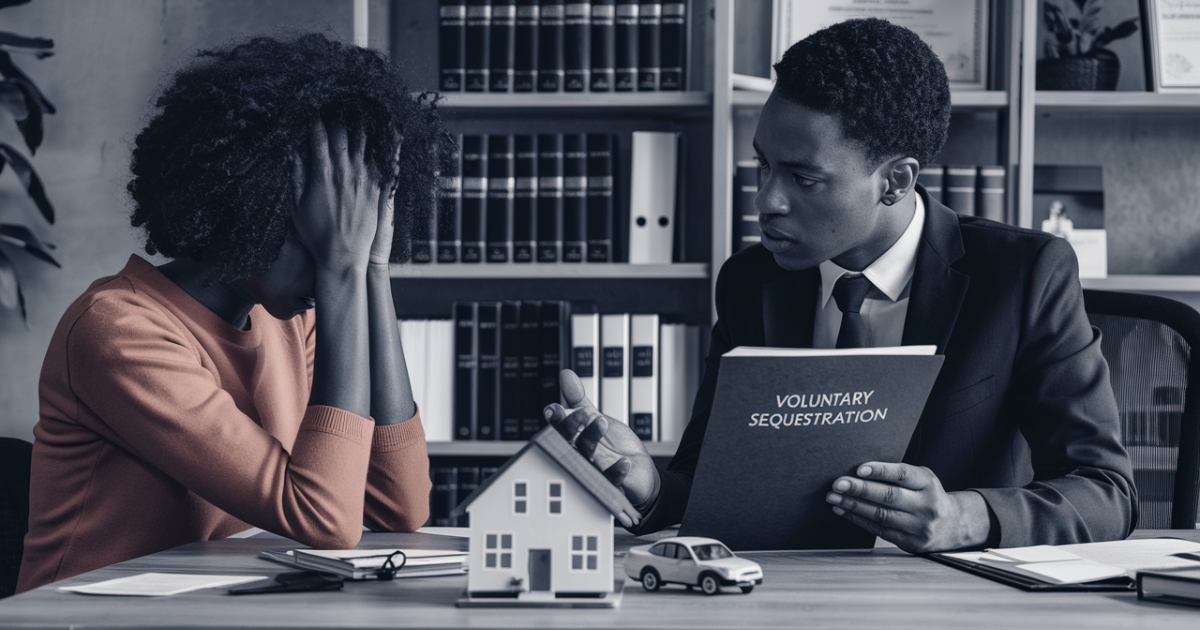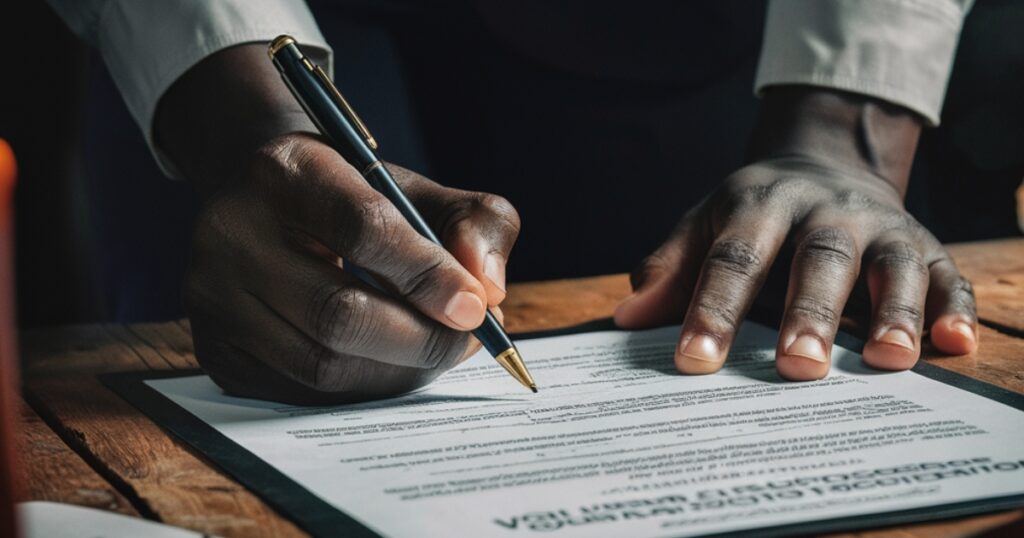
If you’re struggling to manage your debt payments and feel overwhelmed, ignoring the issue can have serious consequences with your creditors, potentially leading to legal action. This can damage your current financial situation and hinder your ability to secure future loans. When other debt relief options have been exhausted, you might want to consider voluntary sequestration as a potential solution.
Key Takeaways
- Debt Relief Option: Voluntary sequestration enables individuals burdened by debt to legally surrender their estate, liquidate assets, and start afresh without the pressure of overwhelming debt.
- Eligibility and Process: To qualify, individuals must demonstrate insolvency, have enough assets to cover costs, and show that sequestration will benefit creditors. A trustee will handle the sale of assets and distribute the proceeds accordingly.
- Pros and Cons: While voluntary sequestration offers significant relief from debt and legal protection from creditors, it comes with the loss of assets, long-term impacts on your credit record, and financial restrictions. It should be considered only after all other debt relief options have been explored.
About Arcadia Finance
Effortlessly obtain your loan through Arcadia Finance. With no application fees and a selection of 19 trustworthy lenders, each adhering to South Africa’s National Credit Regulator standards, you can expect a seamless and reliable service.
What is Voluntary Sequestration?
Voluntary sequestration is a legal process where an individual who cannot repay their debts chooses to surrender their estate to the court to be declared insolvent. This process provides the debtor with a chance for debt relief by liquidating their assets to settle outstanding debts. Once the court accepts the application, a trustee is appointed to oversee the sale of the debtor’s assets and distribute the proceeds to creditors. The aim is to offer the debtor a fresh start without the burden of overwhelming debt while ensuring creditors are treated fairly. However, this is a significant decision with long-term consequences, including restrictions on future credit and financial activities, and should only be pursued after all other debt relief options have been exhausted.
How Does Voluntary Sequestration Work?
When an individual becomes insolvent, they can request the court to sequestrate their estate. For the court to approve this process, three key criteria must be met:
- Proof of Insolvency: The individual must show that their liabilities exceed their assets, confirming their insolvency.
- Sufficient Assets: They must have enough assets to cover the costs associated with the sequestration application.
- Benefit to Creditors: It must be demonstrated that sequestration will benefit creditors by providing at least partial repayment.
If the court grants the sequestration, a trustee or curator is appointed to manage the insolvent estate. The trustee’s job is to sell the debtor’s assets and use the proceeds to repay creditors. If the total amount raised is not enough to cover all debts, the funds are distributed proportionately among creditors based on the amount owed and their payment priority. Any remaining unpaid debt is then written off, allowing the debtor a fresh financial start.
While voluntary sequestration can offer substantial debt relief and an opportunity to rebuild finances, it also has drawbacks, such as long-term impacts on creditworthiness and asset loss, which should be carefully considered before proceeding.
While considering voluntary sequestration, it’s crucial to explore all available options to manage overwhelming debts. Understanding the concept of debt consolidation can provide an alternative route that might better suit your financial circumstances.

Who May Apply for Voluntary Sequestration?
Individual Facing Insolvency
An individual facing insolvency can personally initiate the process of voluntary sequestration. If they are unable to do so themselves, a designated representative can apply on their behalf to handle their financial distress legally.
Married Spouses in Community of Property
When spouses are married under the regime of community of property, both individuals must jointly file for voluntary sequestration. This ensures that the financial affairs and assets of both parties are comprehensively addressed and managed during the insolvency process.
Partners in a Partnership
Partners in a partnership who are residents of South Africa have the right to apply for voluntary sequestration. Alternatively, their appointed representative can file the application to systematically resolve the partnership’s financial obligations.
Executor of a Deceased Estate
If a deceased person’s estate is insolvent, it is the executor’s responsibility to apply for voluntary sequestration. This process helps in the orderly liquidation and settlement of the deceased’s debts, ensuring fair treatment of creditors.
Curator (Curator Bonis)
A curator (curator bonis) assigned to manage the estate of an individual who cannot handle their own financial affairs due to mental incapacity can apply for voluntary sequestration. This legal step helps protect the individual’s financial interests and settle outstanding debts.
Insolvent Trust
An insolvent trust that cannot meet its debt obligations can also seek voluntary sequestration. This process facilitates the structured liquidation of the trust’s assets to pay off creditors and resolve its financial liabilities.
Voluntary Sequestration Requirements
To qualify for voluntary sequestration in South Africa, several specific requirements must be met:
- Factual Insolvency: The debtor must be unable to pay their debts, meaning their liabilities must significantly exceed their assets.
- Asset Sufficiency: The debtor must have enough assets to cover sequestration costs, legal fees, and estate management fees. Additionally, the sale of these assets must provide a minimum benefit to the creditors.
- Income: The debtor should have a steady income to ensure that any remaining debt can be repaid after sequestration.
- Minimum Benefit to Creditors: The assets sold must guarantee that creditors receive at least 20 cents in the rand from the proceeds.

How Much Does Voluntary Sequestration Cost in South Africa?
Here is a table summarising the costs associated with voluntary sequestration in South Africa:
| Cost Component | Estimated Cost (ZAR) | Description |
|---|---|---|
| Legal Fees | R10,000 – R30,000 | Fees charged by attorneys for handling the sequestration process. |
| Court Costs | R5,000 – R15,000 | Expenses for filing the sequestration application in court. |
| Administrative Charges | R5,000 – R15,000 | Costs for managing and administering the insolvent estate. |
| Total Estimated Cost | R20,000 – R60,000 | Combined cost range for the entire sequestration process. |
Please note that these costs can vary significantly depending on the complexity of the case and the specific fees charged by the legal professionals involved. Consulting with a qualified insolvency practitioner or attorney is recommended for an accurate estimate based on your individual situation.
If you’re feeling overwhelmed by debt, you’re not alone. Many South Africans find themselves drowning in debt, seeking various solutions to regain their financial footing. Our resource provides insights into handling excessive debt loads before considering legal options like sequestration.
Advantages and Disadvantages of Voluntary Sequestration
Advantages
- Debt Relief: Voluntary sequestration allows individuals to eliminate unmanageable debt and start fresh financially.
- Legal Protection: Once sequestration begins, the debtor is protected from legal actions and harassment by creditors.
- Debt Discharge: After the sequestration process is complete, the debtor is released from the debts included in the sequestration.
- Asset Management: A trustee manages the debtor’s assets and ensures fair distribution to creditors.
- Reduced Stress: The process helps alleviate the mental and emotional burden of dealing with overwhelming debt and creditor pressures.
Disadvantages
- Loss of Assets: The debtor’s assets, including property and valuable possessions, are sold to repay creditors.
- Credit Record Impact: Sequestration has a long-term negative effect on the debtor’s credit record, making it difficult to obtain future credit.
- Financial Restrictions: The debtor will face restrictions on financial activities and may need permission for significant transactions.
- Professional Implications: Some professions may have restrictions or consequences for individuals who have undergone sequestration.
- Public Record: Sequestration is a matter of public record, which can affect the debtor’s personal and professional reputation.

What Happens When the Voluntary Sequestration Process Has Been Completed?
Once the voluntary sequestration process is completed, the court will officially declare the individual insolvent. A trustee, appointed by the court, will have managed the liquidation of the debtor’s assets and distributed the proceeds to the creditors. The debtor is then relieved of the remaining debt obligations, providing a fresh financial start. However, the debtor will face restrictions on obtaining credit and conducting certain financial activities for a specified period. While this discharge allows the debtor to rebuild their financial stability, it may have long-term impacts on their credit record and financial reputation.
When is Voluntary Sequestration a Good Option?
When other debt relief options are unavailable, voluntary sequestration may be the only viable solution to address your financial challenges. If you find yourself unable to meet your debt repayment obligations and your total debts significantly exceed the value of your assets, sequestration might be necessary to effectively manage your financial situation.
Important Points to Consider:
– No Debt Threshold: There is no specific minimum amount of debt required to qualify for voluntary sequestration.
– Asset Sale Requirement: Once declared bankrupt by the court, you must legally sell your assets.
– Protection from Creditors: The sequestration process legally prevents your creditors from pursuing you further.
– Loss of Property: You will no longer retain ownership of any of your property.
– Contract Restrictions: You are prohibited from entering into contracts independently.
– Credit Application Ban: It is illegal for you to apply for new credit.
– Corporate Restrictions: You cannot be a member of a closed corporation (CC) or a director of a company.
– Credit Qualification: Being declared insolvent means you won’t qualify for new credit for at least 10 years unless the court declares you solvent within that period.
– Alternative Solutions: If the court does not declare you bankrupt, you will need to seek another method to manage your debt.
While voluntary sequestration can significantly reduce your debt, it comes with high expenses, including legal costs and the loss of assets. It may also impact your ability to secure rental housing. Carefully weigh these implications before proceeding with voluntary sequestration.
Legal Aid South Africa offers extensive resources on legal assistance, including details on insolvency and sequestration. Their website serves as a reliable source for understanding the legal frameworks and support available to individuals considering voluntary sequestration in South Africa.
Conclusion
Voluntary sequestration can offer substantial debt relief for individuals overwhelmed by debt, allowing them to achieve a fresh financial start through the legal surrender of assets and their liquidation by a trustee. However, it is a serious decision with long-term effects on creditworthiness, asset loss, and financial restrictions. This option should only be considered after all other debt relief methods have been exhausted and if the individual meets the strict eligibility criteria, ensuring it is a viable and beneficial solution for both the debtor and creditors.
Frequently Asked Questions
Voluntary sequestration is a legal process where an individual who cannot pay their debts chooses to surrender their estate to the court to be declared insolvent. This process allows for the liquidation of assets to pay off creditors and provides the debtor with a fresh financial start.
Disadvantages include the loss of assets, a long-lasting negative impact on the debtor’s credit record, financial restrictions, potential professional implications, and the public nature of the sequestration record. It should be considered only as a last resort after other debt relief options have been exhausted.
The cost of voluntary sequestration in South Africa varies widely due to factors like case complexity, legal fees, and other associated expenses such as court fees and trustee costs. Typically, the cost ranges from R20,000 to over R50,000.
Voluntary sequestration typically lasts for a minimum of four years in South Africa. During this time, the individual faces restrictions on obtaining credit and conducting certain financial activities. The individual may apply for rehabilitation after this period, subject to specific conditions being met.
Yes, if you are married in community of property, both spouses must jointly file for voluntary sequestration. This ensures that the financial affairs and assets of both individuals are addressed and managed during the insolvency process.
Fast, uncomplicated, and trustworthy loan comparisons
At Arcadia Finance, you can compare loan offers from multiple lenders with no obligation and free of charge. Get a clear overview of your options and choose the best deal for you.
Fill out our form today to easily compare interest rates from 16 banks and find the right loan for you.


